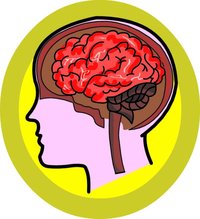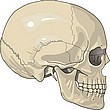Basal ganglia
|
|
The basal ganglia are a group of nuclei in the brain associated with motor and learning functions. However, there is no single definitive function that can be assigned to the mammalian basal ganglia.
The five individual nuclei that comprise the primate basal ganglia are the striatum, external segment of the globus pallidus, internal segment of the globus pallidus, subthalamic nucleus and substantia nigra. Some of these nuclei may be further subdivided (for example, the striatum is often split into putamen, caudate nucleus and nucleus accumbens, and the substantia nigra is generally divided into the "pars compacta" and "pars reticulata").
These images show two schematic coronal cross-sections of the human brain with nuclei of the basal ganglia labelled on the right side. As it refers to a group of nuclei, the term "basal ganglia" is plural (the singular of ganglia is ganglion). There are two complete sets of basal ganglia in the mammalian brain (one under each of the left and right cerebral hemispheres - see the nuclei mirrored on the left and right sides in the above sections). Two coronal sections are used to show the basal ganglia as the smaller subthalamic nucleus and substantia nigra lie deeper back in the brain (more caudal). The abbreviations used are: (GPi) globus pallidus internal segment, (GPe) globus pallidus external segment, (STN) subthalamic nucleus, (SN) substantia nigra.
Classically, these nuclei were considered to be connected as shown (right). The striatum is the primary (but not exclusive) input zone for other brain areas to connect to the basal ganglia. Via the striatum the basal ganglia receives input from the entire cortical mantle, but with a majority of projections from the motor, sensorimotor and prefrontal cortices. Two pathways through the basal ganglia could then be followed.
The direct pathway is via direct connections from the striatum to the substantia nigra pars reticulata (SNr) and the internal segment of the globus pallidus (GPi). These two nuclei are considered "output" nuclei of the basal ganglia as they connect to the thalamus, a primary target of the basal ganglia. The indirect pathway is via connections from the striatum to the external segment of the globus pallidus (GPe), from there to the subthalamic nucleus (STN) and finally to the basal ganglia output nuclei (GPi and SNr).
There is still debate as to how the basal ganglia processes information from the cortex. We now know that the individual nuclei are more highly interconnected than the classic diagram shows. It is also likely that not all the pathways and loops of connectivity have been determined.
Neurons of the various basal ganglia nuclei use a variety of neurotransmitters. The most widely used is the inhibitory transmitter GABA (connections using GABA are shown in blue in the connectivity diagram above). Of particular interest is the neurotransmitter of the pigmented substantia nigra pars compacta neurons, called dopamine. Disruption in the production or transmission of this transmitter can lead to serious motor and cognitive deficits (for example, see Parkinson's disease). The substantia nigra pars compacta (SNc) primarily targets the striatum with this neurotransmitter (shown as the magenta connection in the classic connectivity diagram above), and it is thought to play an important role in learning (see LTP/LTD).
"Basal ganglia"-like areas are observed in the central nervous systems of many species. The names given to the various nuclei comprising the basal ganglia can vary greatly depending on species. For example, the internal segment of the globus pallidus in primates is called the entopenduncular nucleus in rodents.
Disorders linked with the basal ganglia
History
The first anatomical identification of distinct subcortical structures was published by the English anatomist Thomas Willis in 1664. At that time it was referred to as the corpus striatum (comprising only the globus pallidus segments and striatum). At the beginning of the 20th century it was associated with movement functions as lesions of these areas would often result in disorders of motor function in humans.
Anatomy Clipart and Pictures
- Clip Art (https://classroomclipart.com)
- Anatomy Illustrations (https://classroomclipart.com/clipart/Illustrations/Anatomy.htm)
- Anatomy Clipart (https://classroomclipart.com/clipart/Anatomy.htm)
- Anatomy Animations (http://classroomclipart.com/cgi-bin/kids/imageFolio.cgi?direct=Animations/Anatomy)


